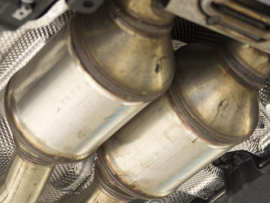This OBD-2 code indicates a problem with the oxygen sensor located in Bank 2 of the engine, which is the side that does not contain the number 1 cylinder. The sensor in question is the upstream sensor (Sensor 1), which is situated before the catalytic converter. Its primary function is to measure the oxygen content in the exhaust gases and provide this data to the engine control module (ECM) for proper fuel mixture control. When the ECM detects a problem with the heater circuit in Bank 2 Sensor 1, it will trigger the DTC P0155 and illuminate the check engine light on the dashboard.
The most common causes of P0155 include a faulty oxygen sensor heater element, issues with the sensor’s wiring or connectors, or a blown fuse related to the sensor’s heater circuit. When diagnosing and resolving this code, it’s crucial to use a professional scan tool to retrieve specific trouble codes and perform further testing on the affected sensor and its related components.
Fixes for OBD-II Code P0155
Note: If you’re unsure or encounter difficulties during the process, it’s best to seek assistance from a qualified mechanic who can perform a thorough diagnosis and ensure proper repair.
To fix the P0155 OBD-II code, you can follow the steps:
- Check for other trouble codes. Start by using a professional OBD2 scan tool to check if there are any other trouble codes present. Addressing any additional codes may help in identifying related issues.
- Inspect the wiring and connectors. Carefully inspect the wiring and connectors associated with the oxygen sensor in Bank 2 Sensor 1. Look for signs of damage, corrosion, or loose connections. If any issues are found, repair or replace the affected wiring or connectors.
- Test the oxygen sensor. Use a digital multimeter to check the oxygen sensor’s heater element. Disconnect the sensor and measure the resistance across the heater circuit terminals. Compare the measured resistance to the manufacturer’s specifications. If the resistance is out of range, the oxygen sensor may need replacement.
- Check the fuse. Locate the fuse related to the oxygen sensor heater circuit in the vehicle’s fuse box. Use a fuse tester or visually inspect the fuse to determine if it is blown. If the fuse is blown, replace it with a new one of the same rating.
- Verify ECM operation. Ensure that the engine control module (ECM) is functioning correctly. While uncommon, a faulty ECM can also cause the P0155 code. If necessary, seek professional diagnostics to evaluate the ECM’s performance.
- Replace the oxygen sensor. If all other components and connections are in good condition, and the oxygen sensor’s heater element has failed or is out of range, consider replacing the oxygen sensor with a new, compatible one.
- Clear the trouble codes. After completing the repairs, use the OBD2 scan tool to clear the trouble codes from the vehicle’s memory. This will reset the check engine light. If the issue has been successfully resolved, the light should stay off.
Related DTCs to P0155
There are some codes that likely would have been shown along with the aforementioned code: P0130, P0135, P0141, P0161, P0420, P0430.
FAQs
How much does it cost to fix the code P0155?
Total average cost to fix code P0155 on the date of publication can range from approximately $150 to $600 or more, depending on various factors such as the vehicle make and model, the brand and quality of the oxygen sensor, labor rates in your area, and whether you choose to go to a dealership or an independent repair shop.
Can I continue driving with the P0155 code?
It is generally not recommended to continue driving with the P0155 code. Ignoring this issue can lead to potential performance problems, reduced fuel efficiency, and increased emissions. It’s because the ECM won’t be receiving accurate data from the affected oxygen sensor and it can mask other underlying issues with the vehicle.
How is the code P0155 serious?
It is a serious issue that should not be ignored. The P0155 code can lead to further damage to the vehicle’s emission control system and potentially cause additional issues with other components. It can also trigger other related fault codes.
We do an efforts to find, research and recommend the best products. So, we may receive commissions from purchases that you make after following the links in our product reviews.








Leave A Comment